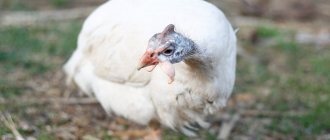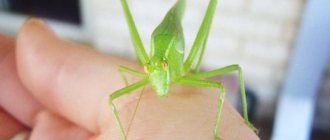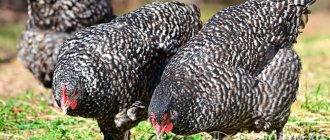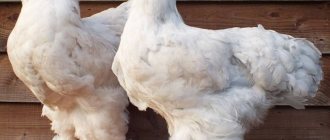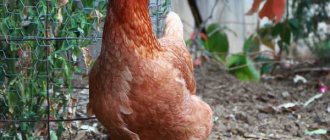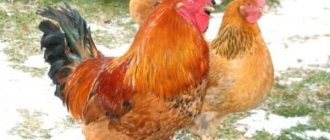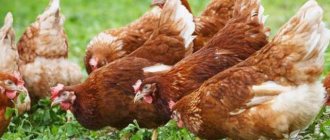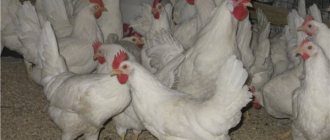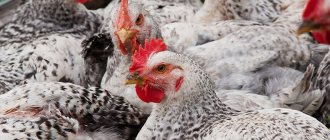These chickens, original in appearance and coloring, have been famous in Russia since the 18th century. After the revolution and civil war, their population was practically destroyed. In the 80s of the last century, the Pavlovsk chicken breed was restored.
Pavlovsk chickens are now classified as a precocious ornamental breed; they are not raised on an industrial scale. Amateur poultry farmers breed unusually beautiful birds in their private backyards and small farms. At its core, this is a meat-egg breed with average egg production and tasty, tender meat.
Pavlovsk chickens can withstand frosts of -25-27 degrees, they have rich plumage with thick down and their paws are covered with feathers, so they are not afraid of cold weather and love to walk in the snow in winter.
History of the breed
Photo:
Chickens of this breed were bred in the village of Pavlovo, Nizhny Novgorod region, which determined their name. In 1899, at an exhibition in Moscow, the breed received national status.
Since the 19th century, Pavlovsk chickens have been widespread in many countries of Europe and Asia, where they won recognition, but in their homeland they were undeservedly forgotten. During the October Revolution, the Civil War and subsequent dispossession, they were almost physically destroyed.
Fortunately, at the end of the last century, breeders miraculously managed to restore the breed to its original form. To achieve this, several breeds were crossed - Dutch, Sultan, Faverolles and La Freche.
Description, characteristics of the breed
The Pavlovsk chicken breed is small in size, strong built, with a crest and beard, with thick plumage on the body and legs.
The distinctive features of Pavlovsk breed chickens are:
- Small round head, thin straight beak.
- Round large dark eyes.
- The main characteristic of the breed is the crest. It grows in a sheaf upwards, and then scatters like a fountain; in another case, it grows helmet-shaped, compressed on the sides and leans forward. crests should not interfere with the eyes. Otherwise, this is a sign for culling.
- The comb is small, similar to horns.
- The earrings are small, covered with beard feathers.
- The beard and sideburns are thick, covering almost the entire face and throat.
- The face is red.
- Not very long neck, densely covered with feathers.
- The wings are wide, of medium length, tightly pressed to the body.
- The tail is large and full, beautifully flowing, directed towards the back at a right angle.
- The lower legs are densely feathered. Under the knee there is a hawk's tuft - feathers arranged in a fan, thanks to which the bird can sit on them, like on a bedding, in the snow.
- The lower parts of the legs are gray or blue, well feathered, and the feathers are pressed to the leg and do not stick out to the sides.
- There should be 4 toes on the paw and all of them are feathered at least ¼ of the length.
Roosters differ from hens in that they have a large, widely spread tail. In chickens, the earrings are almost invisible, but the beard, crest and sideburns are larger than those of a rooster. The weight of a rooster is in the range of 1.5-2.2 kg, of a chicken - 1.3-1.5 kg.
Characteristics of Pavlovsk chickens
Chickens of this breed are very active, agile, love to run, and fly over obstacles with changes in direction. They are attached to their home and never run far from the chicken coop. Chickens are more sedate and calm.
Roosters have a warlike disposition and love to fight among themselves. They do not come into conflict with other bird breeds and are friendly towards humans.
Signs for culling
- Lack of crest or too large crest that interferes with vision.
- Lack of feathering on legs.
- No beard.
- Fifth toe or brain hernia.
- Extraneous color in the color of the body and color of the legs that does not correspond to the overall color.
Subspecies
The breed line of Pavlovian chickens is divided into two main subspecies.
Silver
The main colors of silver pavlovkas are white, diluted with silver or gray-black splashes. Intense shine is observed only in dark areas where there is a green tint.
Golden
Golden and brown hens and roosters are distinguished by their bright plumage. The brown color of the feathers at the ends smoothly turns into black, folding into a V-shaped “edging” that begins on the crest and passes through the neck, shoulder area and back to the lumbar region.
On the outside the protective cover is spotted. The first order feather is brown-gold inside, much darker outside.
Varieties of Pavlovsk breed of chickens
- Golden Pavlovsk chickens. This is the most common variety. The main color of the feathers is golden with a black spot at the end of each feather. These spots in some places have the shape of the Latin letter V. The sideburns and crest can be black or variegated. For this colorful elegant plumage, they are popularly called “gold”.
- Silver Pavlovsk chickens. They rank second in popularity. The main color of the plumage is white or silver, with a scattering of black spots of various shapes of the correct appearance.
- White Pavlovsk chickens. They are very rare and are often subject to rejection due to non-compliance with the standard. The color of the plumage is snow-white.
- Porcelain Pavlovsk chickens. Their feathers are painted in such a variety of colors that it is difficult to single out one of them.
- Yellow Pavlovsk chickens. The color of the feathers of these birds is closer to red or fawn.
- Black Pavlovsk chickens. These chickens are black in color and resemble Siberian moths in appearance.
Character
Pavlovsk chickens are active, curious and emotional. They rarely sit, but rather run around the yard, rummage in the ground or litter, and also periodically improve their flying skills. Pavlovkas are light in weight, so they do not require long acceleration. By flapping their wings, the birds easily overcome high fences. If you don't keep track, they may leave the yard forever. Their flight is high and beautiful. It’s not easy to catch, because chickens are excellent at maneuvering on the ground and in the air.
Female pavlovkas are noisy and shy. A loud sound or the appearance of a dog is quite a reason to panic. At the alarm, the population of the chicken coop flees. The quolls scream, rush about, and flap their wings. Females, like males, are quite conflicted. They do not attack the owner, but they get used to it with difficulty if they were brought in as adults. Roosters do not tolerate competitors, so they rush at feathered relatives that are larger in breed. But they live peacefully with ducks and geese. Guinea fowl and turkeys are also not touched.
Reviews
Based on reviews from poultry farmers, the following positive qualities of Pavlovsk chickens can be identified:
- Picturesque appearance combined with average egg production and tasty meat.
- High frost resistance, ability to withstand temperatures down to -36 degrees.
- The eggs of this breed of chicken are close in composition to quail eggs and can be safely eaten by people suffering from allergies.
- Unpretentiousness in feed and care.
- High percentage of chick survival.
- Good disease resistance.
Disadvantages include:
- The dangers of buying defective chickens.
- Low productivity of the breed.
Frequent illnesses
The breed has good immunity due to the abundance of green food in its diet. They are resistant to colds and other diseases.
Problems related to the liver are dangerous. They appear when the owner gives a large amount of vitamin supplements. In this case, they poison the bird.
Due to a lack of calcium, pavlovkas may lay eggs without shells or with fragile shells. In this case, the birds are given additional feed chalk or shell rock.
Pavlova chickens
Productivity and egg production
With good care and nutrition, the weight of an adult rooster reaches 3 kg, and a chicken – 2 kg. In a year, a laying hen can produce from 150 to 300 eggs. The shell is white, creamy or beige, the weight of the egg is 50-65 g. Laying hens begin to lay eggs from the fifth month of life and their productivity lasts 4 years.
The maternal instinct of Pavlovsk hens is highly developed; they are excellent hens and caring mothers. Hence the high percentage (90%) of offspring survival. This quality of Pavlovian hens is often used to place eggs of other breeds in their nests for incubation.
Diet
Compared to broilers and egg breeds, Pavlovskaya looks like a fairly economical bird. Thanks to its high activity, it very readily catches bugs and pecks grass, allowing you to significantly save on its maintenance.
The basics of the Pavlovskaya diet, like any other breed, should consist of the following products:
Cereals. This is the basis of the poultry diet. Grains should account for at least 50% of a chicken's total diet. They can be given either whole or ground. Also, many poultry farmers practice feeding sprouted grain to birds in order to increase their egg production. It is advisable to give grains in the morning (1st feeding) and in the evening (last feeding). Mash. The mashes play a vital role in the diet of poultry during the winter period. In addition to the fact that they contain all the useful substances that chickens need, they can also warm the bird in winter, reducing its energy consumption. You can add sources of calcium, vegetables, and grains to the mash. Also, they are often cooked in meat broth, although plain water is also quite suitable. Source of calcium
It is very important to provide the bird with sources of calcium if the purpose of its breeding is to obtain egg products. When a bird does not have enough calcium, it begins to produce eggs with thin shells or no shells at all.
The main sources of calcium are: crushed shell rock, food chalk and crushed eggshells. If possible, meat and bone and fish meal should be included in the poultry diet. Vegetables. Vegetables are rich in beneficial elements. The bird should be given fresh cabbage, zucchini, pumpkin, potatoes, etc. Grass and greenery. Grass can significantly reduce the cost of feeding poultry. You can give the grass yourself or let the chickens go for a walk in the places where it grows. Then the bird itself will choose exactly the greenery that it likes. Yeast. They are given to the bird when it is very much behind in development.
Usually chickens are fed 3-4 times a day. In the morning they give most of the grains (about 65-70% of the daily norm), in the afternoon they give mash, vegetables, and grass. In the evening they give the rest of the grain allowance.
Content Features
- Since Pavlovian chickens are very active, it is not advisable to keep them in cages. It is necessary to allocate a sufficiently large area for a chicken coop and a pen for walking at the rate of 1 square meter for 3 laying hens. Given the aggressiveness of Pavlovsk cockerels, it is better to place them in different fenced areas.
- The Pavlovsk breed is quite frost-resistant; they can easily walk and sit in the snow and withstand frost in sheltered areas from the wind. The optimal temperature in the chicken coop in winter is 10-15 degrees Celsius.
- Chicken coops, feeders, drinking bowls and perches should be spacious, Pavlovsk chickens do not like to crowd, access should be free everywhere.
- The chicken coop has a window and an insulated hole underneath. Hay, straw or sawdust is placed on the floor. Nests are attached to the walls, into which hay and straw are also placed. A perch is made at a height of 80 cm from the floor. Feeders must be washed periodically.
- Be sure to place containers with chalk sand and shell rock in the chicken coop, in which chickens love to swim, thereby ridding themselves of fleas and other parasites.
Feeding
Chickens of this breed are not demanding on their diet and consume little feed. In the summer, they completely find their own food - greens, worms and insects.
In winter, they need to be given grain, wet food, bran, vitamins, and mixed feed at the rate of 50 g per individual. The winter diet should consist of 1/3 solid food, and the rest - semi-liquid mash.
Vitamin mixtures are made from grated carrots, nettles, potatoes, and fruits. Be sure to add bran, salt, chalk, and white bread to the diet.
To produce eggs, laying hens need protein, so bone, meat, fish meal, cottage cheese, curdled milk, beans and bean flour, and various cakes are added to the feed.
During the molting period, it is especially necessary to monitor the diet of chickens; minerals, fats, and vitamins must be present in the feed. At this stage, chickens should be kept warm, if possible, and fed intensively. Egg laying may be stopped during the molting period, but then it is restored.
Care
Representatives of this breed do not require special care. Once a year, the entire litter in the chicken coop is changed and the walls are covered with slaked lime. In the nests, the hay is changed once a month.
All drinking bowls and feeders are washed when they become dirty, and they are treated with an antiseptic every two months. Other activities are related to regular treatment for parasites, feeding, and egg collection.
Some birds may peck the eggs. To prevent this phenomenon, it is better to install nests with a special collection box.
In winter, a source of artificial light will be required to extend daylight hours to 16 hours a day. This is necessary to maintain high egg production.
Feeding
Pavlovkas are undemanding when it comes to diet. In summer they have enough worms, insects, and greenery. Therefore, standard food is reduced to a minimum. It is very simple to check the degree of hunger of a bird - just touch the crop; if it is full, the chicken is full. On average, she needs 50 g of feed.
Pavlovkas are undemanding to the diet
In winter, a multi-component diet is prepared. It includes:
- waste from fish and meat;
- compound feed;
- herbal flour;
- grain mixtures;
- whey;
- mash;
- vitamins and minerals.
Portions should be small, eaten within half an hour. The water is changed in the morning and evening, and the drinking bowl is washed regularly.
Breeding and keeping chickens
To produce chicks, large eggs weighing 60 g are selected. Chicks are usually hatched naturally or in an incubator. Pavlovsk hens are excellent mothers, they hatch eggs productively, take good care of the brood - they warm the chicks, provide shelter, teach them to find food for themselves, and make sure they don’t get lost.
If chickens are hatched in an incubator, then a special place is fenced off for the hatched chicks and lighting and heating are installed there. For the first 5 days of life, chickens need a room temperature of +30 degrees, in the next 5 days - +26 degrees, then the temperature is successively reduced to +18.
It is necessary to constantly monitor the temperature and behavior of the chickens. If everything is normal, then they eat calmly, do not crowd, and behave actively. If they are too cold, they huddle together, can trample weak relatives, cling to a heat source, and eat poorly. If it is too hot, the chickens open their beaks and wings, drink a lot and refuse to feed.
The chicks are born very heavily pubescent, dark spotted in color, feathers appear quickly, golden, silver with dark spots.
Feeding the chickens
- For the first 2 days, chickens are fed a mixture of cottage cheese with hard-boiled eggs, boiled millet and corn flour.
- On days 3 and 4, add boiled potatoes, fresh alfalfa, clover, nettles, and grated carrots.
- From the 5th day they give wet and dry mash, dairy and animal feed, tops, grass, yeast.
The food must be balanced and varied; the growth rate and survival of the chicks depends on this.
Grown-up chicks are fed, like adult chickens, 3-4 times a day. In the morning, it is advisable to give them 1/3 of solid feed, after 2 hours - wet mash, in the evening - the rest of the grain feed.
Breeding
Traditionally, there are two ways to raise chickens at home - purchasing fertile adults or hatching chicks. The first method is the most convenient, since you can visually detect all the shortcomings of the breed and select the most beautiful and strong individuals.
The price of Pavlovsky chickens has dropped significantly in recent years, so standard birds can be widely purchased from breeders relatively inexpensively. It is worth paying attention to the plumage and anatomical features. If you buy adult chickens, you need to pay attention to the sex composition. Usually 3-4 chickens are bought for one rooster.
Chickens hatch their offspring with great pleasure and then protect them. In order for the chicks to hatch from the eggs, you should purchase only large individuals weighing more than 60 grams. Up to 3-4 eggs can be laid for a large laying hen; due to warm plumage, chicks may appear even earlier than expected.
